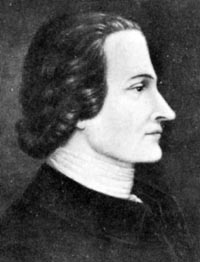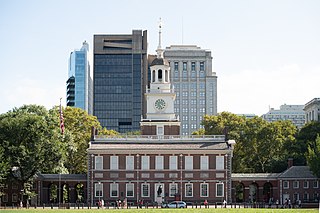
The Continental Congress was a series of legislative bodies, with some executive function, for the Thirteen Colonies of Great Britain in North America, and the newly declared United States before, during, and after the American Revolutionary War. The Continental Congress refers to both the First and Second Congresses of 1774–1781 and at the time, also described the Congress of the Confederation of 1781–1789. The Confederation Congress operated as the first federal government until being replaced following ratification of the U.S. Constitution. Until 1785, the Congress met predominantly at what is today Independence Hall in Philadelphia, though it was relocated temporarily on several occasions during the Revolutionary War and the fall of Philadelphia.

Joseph Hewes was an American Founding Father and a signer of the Continental Association and U.S. Declaration of Independence. Hewes was a native of Princeton, New Jersey, where he was born in 1730. His parents were members of the Society of Friends, commonly known as Quakers. Early biographies of Hewes falsely claim that his parents came from Connecticut. Hewes may have attended the College of New Jersey, known today as Princeton University but there is no record of his attendance. He did, in all probability, attend the grammar school set up by the Stonybrook Quaker Meeting near Princeton.

George Taylor was an American ironmaster and politician who was a Founding Father of the United States and a signer of the United States Declaration of Independence as a representative of Pennsylvania. His former home, the George Taylor House in Catasauqua, Pennsylvania, was named a National Historic Landmark in 1971.

Independence Hall is a historic civic building in Philadelphia, where both the United States Declaration of Independence and the United States Constitution were debated and adopted by America's Founding Fathers. The structure forms the centerpiece of the Independence National Historical Park and was designated a World Heritage Site in 1979.

The Second Continental Congress was the late-18th-century meeting of delegates from the Thirteen Colonies that united in support of the American Revolution and the Revolutionary War, which established American independence from the British Empire. The Congress constituted a new federation that it first named the United Colonies, and in 1776, renamed the United States of America. The Congress began convening in Philadelphia, on May 10, 1775, with representatives from 12 of the 13 colonies, after the Battles of Lexington and Concord.

The Pennsylvania Constitution of 1776 was the state's first constitution following its declaration of independence and has been described as the most democratic in America. It was drafted by Robert Whitehill, Timothy Matlack, Dr. Thomas Young, George Bryan, James Cannon, and Benjamin Franklin. Pennsylvania's innovative and highly democratic government structure, featuring a unicameral legislature and collective executive, may have influenced the later French Republic's formation under the French Constitution of 1793. The constitution also included a declaration of rights that coincided with the Virginia Declaration of Rights of 1776.

John Dickinson, a Founding Father of the United States, was an attorney and politician from Philadelphia, Pennsylvania, and Wilmington, Delaware. Dickinson was known as the "Penman of the Revolution" for his twelve Letters from a Farmer in Pennsylvania, published individually in 1767 and 1768, and he also wrote "The Liberty Song" in 1768.

Joseph Galloway was an American attorney and a leading political figure in the events immediately preceding the founding of the United States in the late 1700s. As a staunch opponent of American independence, he would become one of the most prominent Loyalists in North America during the early part of the Revolutionary War.

The committees of correspondence were a collection of American political organizations that sought to coordinate opposition to British Parliament and, later, support for American independence during the American Revolution. The brainchild of Samuel Adams, a Patriot from Boston, the committees sought to establish, through the writing of letters, an underground network of communication among Patriot leaders in the Thirteen Colonies. The committees were instrumental in setting up the First Continental Congress, which convened in Philadelphia in September and October 1774.

The First Continental Congress was a meeting of delegates of 12 of the Thirteen Colonies held from September 5 to October 26, 1774 at Carpenters' Hall in Philadelphia at the beginning of the American Revolution. The meeting was organized by the delegates after the British Navy implemented a blockade of Boston Harbor and the Parliament of Great Britain passed the punitive Intolerable Acts in response to the Boston Tea Party.

Independence National Historical Park is a federally protected historic district in Philadelphia, Pennsylvania that preserves several sites associated with the American Revolution and the nation's founding history. Administered by the National Park Service, the 55-acre (22 ha) park comprises many of Philadelphia's most-visited historic sites within the Old City and Society Hill neighborhoods. The park has been nicknamed "America's most historic square mile" because of its abundance of historic landmarks.

William Montgomery was a colonial-American patriot, pioneer, soldier, public servant, and abolitionist.

Pennsylvania was the site of many key events associated with the American Revolution and American Revolutionary War. The city of Philadelphia, then capital of the Thirteen Colonies and the largest city in the colonies, was a gathering place for the Founding Fathers who discussed, debated, developed, and ultimately implemented many of the acts, including signing the Declaration of Independence, that inspired and launched the revolution and the quest for independence from the British Empire.

Christ Church is an Episcopal church in the Old City neighborhood of Philadelphia, Pennsylvania, United States. Founded in 1695 as a parish of the Church of England, it played an integral role in the founding of the Protestant Episcopal Church in the United States. In 1785, its rector, William White, became the first Presiding Bishop of the Episcopal Church.

The George Taylor House, also known as George Taylor Mansion, was the home of Founding Father George Taylor, a signer of the United States Declaration of Independence, in Catasauqua, Pennsylvania in the Lehigh Valley region of eastern Pennsylvania. The home was built by Taylor in 1768 and designated as a National Historic Landmark in 1971.

The Carpenters’ Company of the City and County of Philadelphia is the oldest extant craft guild in the United States. Founded in 1724, the Company consists of nearly 200 prominent Philadelphia area architects, building contractors and structural engineers and has had nearly 900 members in its almost three centuries of existence. The Company built, owns and continues to operate Carpenters' Hall located in Philadelphia's Independence National Historical Park. In 1774 the Hall served as the site of the First Continental Congress.

The following outline is provided as an overview of and topical guide to Philadelphia:

The Pennsylvania Provincial Conference, officially the Provincial Conference of Committees of the Province of Pennsylvania, was a Provincial Congress held June 18–25, 1776 at Carpenters' Hall in Philadelphia. The 97 delegates in attendance involved themselves in issues relating to declaring Pennsylvania's support for independence and to planning for a subsequent gathering that would develop Pennsylvania's new Frame of Government. They achieved these objectives by formally:
Benjamin Loxley, also known as Benjamin Lockley was a Philadelphia carpenter-architect, master builder, investor and military leader in the American Colonial Period. He began his career by working as a carpenter-architect and renting out land outside the city. He then worked as a master builder and built various properties in the city. He invested in many schemes and was a member of the Carpenters' Company of the City and County of Philadelphia.



























